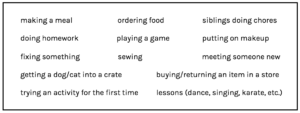Have you ever sat down to write, but just couldn’t think of a good idea? It’s called writer’s block, and it’s an ugly beast that every writer has had to battle at one time or another. There are many ways to conquer this monster, but today I’m going to tell you about my favourite. It’s simple, and it’s fun.
Step 1:
Brainstorm a short list of ordinary activities—the kinds of things that everyone has done, or at least seen someone else do. Here’s a list for you if you’re stuck:
Step 2:
Choose one of the activities from the list. Easy peasy. (I’ve seen some kids make this step way too hard, trying to pick the perfect idea. Don’t do it! Just pick one, and if it doesn’t work, you can always choose another.)
Step 3:
This is the fun part. Now that you have your ordinary activity, to turn it into a good story you just need to ask yourself one simple question: What could go wrong? Get a little list going—not too long, just a few ideas. Then play around with them. (Playing around with ideas is one of the most important jobs of a writer. Which is yet another reason why writing is awesome!)
Example:
Looking at the first idea on my list (making a meal), I think of a famous Mr. Bean sketch where he is preparing a turkey for Christmas dinner. Have you ever seen it? (If you haven’t, stop and watch it right now! It’s hilarious!) Mr. Bean begins to stuff the gigantic turkey, reaching inside well past his elbow. So far, no story. But then I imagine the writers asking themselves, “What could wrong? What if his watch came off in there?” And that’s exactly what happens. Bingo. Now we have a story.
Step 4:
To make a really good story, once something goes wrong, you need to make the problem get bigger. Usually this happens when someone in your story tries to solve the problem, but fails. If they try something foolish, it’s even more fun. In the Mr. Bean sketch, he can’t see his watch, so he sticks his head inside the turkey, and of course it gets stuck. Then his girlfriend comes to the door, making the problem bigger for a second time. She has to wait for him for a long time while he stumbles around on his way to answer the door, so she asks, “Are you all right in there?” He could say, “No,” and open the door. Then she’d help him get the turkey off his head, and the problem would be solved. But the writers have him say he’s just fine, leading to much more silliness as he tries to hide the gigantic turkey from her when she comes in.
The key with this step is to keep it simple. Many of the worst stories I’ve read from former students were ones where they tried to make the problem bigger over and over . . . and over . . . and over . . . and the story just seemed to go on forever. In the best stories, it grew two or three times at the most, then they moved on to the final step.
Step 5:
Solve the problem. If your main character has a turkey on his head, he needs to get it off. Or, maybe he can’t, and we discover that he simply lives the rest of his life turkey-headed. Either way, we say the problem is resolved, which means that the reader finds out how it ends up.
And that’s all there is to it. So now, next time you sit down to write and writer’s block stares you in the face, you don’t have to let it stress you out. You know how to defeat it. Just look right back into its one big hairy eyeball, and ask it a simple question: “What could go wrong?” It’ll get confused (writer’s block isn’t very clever), and while it’s rattled, you can get started with step one. Before you know it, you’ll have yourself a great little story, and writer’s block will run home crying to its mommy.
What about you? Do you ever struggle with writer’s block? Any tricks that work for you? I love to hear from my readers, so share your thoughts (under “Get in Touch”, just to the right of this post).
- The Adventures of Bella - November 14, 2020
- Writing With Robin, #4: Characters - April 29, 2019
- Writing With Robin, #3: Defeating Writer’s Block - March 8, 2018


